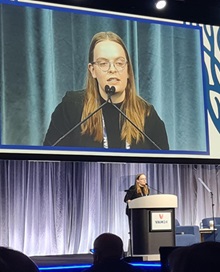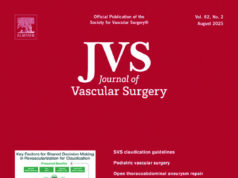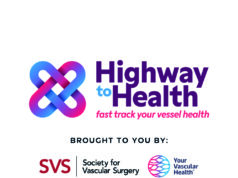
A “feasible and reproducible” intervention bundle characterized by surveys, provider education and patient screening has demonstrated the potential to not only identify gaps in peripheral arterial disease (PAD) primary care practices, but also to help address them. This was a salient concluding message delivered yesterday morning at the Vascular Annual Meeting (VAM; June 19–22) by Zoe Davis, a third-year medical student at the University of Oklahoma (OU) in Tulsa, whose team set out to identify and reduce limb-amputation risks among Oklahoma’s Chickasaw Nation community.
Audience discussions around this research were led by Fernanda Costa Sampaio Silva, MD, a board-certified vascular surgeon and vascular sonographer at the Federal University of Bahia in Salvador, Brazil, who is also part of the SVS’ Diversity, Equity and Inclusion (DEI) Committee.
“Your work is an example of how diversity in vascular teams can improve patient access to specialized care,” Costa Sampaio Silva said. “By assessing primary care practices, a multi-professional vascular team can achieve impacts on early diagnosis and promote standardized PAD management among underserved populations.”
Costa Sampaio Silva also noted that, through the study, vascular teams were able to establish a “bond” with the Chickasaw community—which, in turn, can improve patient trust and adherence to treatment. “So,” she added, “the ‘Caring For Our Feet’ program is a feasible and reproducible strategy that may serve as a model for further implementation in other communities, reducing disparities in access to vascular care.”
Caring For Our Feet
Speaking during yesterday morning’s Plenary Session 3, Davis—presenting on behalf of senior author Kelly Kempe, MD, associate professor of surgery at OU-Tulsa, and colleagues—began by outlining key motivations behind the study.
“A recent, 12-year review of our state’s hospital discharge data found that amputations—including major amputations—are on the rise in Oklahoma,” she said. “First Americans with a diagnosis of diabetes and/or PAD have one of the highest rates of lower-limb amputation.”
The speaker went on to note that, in an effort to combat limb loss and care disparities, multiple published guidelines have advocated multimodal approaches and consistently recommended provider education on PAD, and limb-loss prevention.
“Given this information, our OU-Tulsa multidisciplinary team partnered with the Chickasaw Nation to create a pilot outreach program,” Davis added, relaying that the project has “affectionately” been dubbed “Caring For Our Feet.” Its objective was to conduct a needs assessment of primary care practices, and it also sought to begin building a systems-based strategy for the early detection and prevention of PAD.
Davis and colleagues hypothesized that direct, in-person engagement would lead to a significant increase in awareness of amputation risks. Their study involved conducting four standardized visits with each of the four Chickasaw Nation primary care clinics. Visit number one was completed virtually and involved the distribution of electronic pre-surveys, while visits two and three consisted of in-person sessions centered on provider and patient education, screening, and semi-structured interviews. Their fourth and final visit was performed online and provided a “wrap-up,” feedback, and distribution of post-surveys.
All four Chickasaw Nation practices participated, Davis continued, also reporting an observed practitioner completion rate of 88% across their pre- and post-surveys. She stated that field notes indicated high receptivity and inquiry among participants based on lectures and discussions—and, overall, 27 out of 28 survey measures (96%) showed improvement, with 21 of these (75%) being statistically significant (p<0.05).
“From pre- to post-survey, we saw an improvement in clinicians’ self-reported comfort in treating, diagnosing and educating patients at risk for limb-loss due to chronic disease,” the presenter said. Prior to concluding, Davis also reported that—across the 20 high-risk patients recruited and identified by the clinics—screening revealed that 40% left with a new diagnosis of PAD.
“To summarize,” she said, “this early-needs assessment shows that there are practice gaps that, if addressed, could improve the prevention and, importantly, early management of patients who may be at risk for limb-loss. We believe this is a viable strategy for the creation of a patient-to-provider-to-specialist network, given the high practitioner engagement on our surveys, our survey measures showing improvement after our intervention, and our ability to newly diagnose PAD in patients identified by the clinic.”
Future directions
Providing an early window into where this research may lead, Davis then relayed that she and her colleagues are “in the process” of performing ongoing qualitative and quantitative analyses—as well as attempting to replicate the strategy with additional clinics. She added: “Our future plans are currently to expand this program more broadly across Oklahoma, to reach more people who may be at risk for limb-loss in their future, as well as—potentially, if successful—nationwide.”
When asked by Costa Sampaio Silva how the team may ‘upscale’ these strategies to state-wide or even national levels, Davis reported that feedback and direct engagement with the Chickasaw Nation community were a “very important” aspect of the present project. According to Davis, these efforts ensured OU-Tulsa multidisciplinary teams were providing appropriate, implementable materials for the local community’s practice—and the same factors are likely to be vital in any attempts to scale the project up moving forward.
“As far as scaling up this project [goes], and making it accessible to more Oklahomans, we are interested in contacting additional clinic sites within other tribal nations, as well as continuing to get feedback from providers who are participating in the program to ensure that we’re delivering content that is relevant to them and, most importantly, usable for them in their practice,” Davis added.













